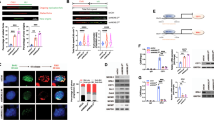Abstract
The molecule 8-oxo-7,8-dihydroguanine (8-oxoGua), an oxidized form of guanine, can pair with adenine or cytosine during nucleic acid synthesis. Moreover, RNA containing 8-oxoGua causes translational errors, thus leading to the production of abnormal proteins. Human NUDT5, a MutT-related protein, catalyzes the hydrolysis of 8-oxoGDP to 8-oxoGMP, thereby preventing misincorporation of 8-oxoGua into RNA. To investigate the biological roles of NUDT5 in mammalian cells, we established cell lines with decreased level of NUDT5 expression. In NUDT5 inhibited cells, the RNA oxidation was not significantly higher than that of normal cells. However, the cell cycle G1 phase was significantly delayed, and cell numbers in both S and G2/M phases were reduced, indicating that cell proliferation was hampered by NUDT5 suppression. Key proteins for preventing the G1-S transition, including p53, p16, and Rb were increased, while the Rb phosphorylation was decreased. These results suggested that the NUDT5 protein may play significant roles in regulating the G1-S transition in mammalian cells.





Similar content being viewed by others
References
Wood ML, Dizdaroglu M, Gajewski E, Essigmann JM (1990) Mechanistic studies of ionizing radiation and oxidative mutagenesis: genetic effects of a single 8-hydroxyguanine (7-hydro-8-oxoguanine) residue inserted at a unique site in a viral genome. Biochemistry 29:7024–7032
Moriya M, Ou C, Bodepudi V, Johnson F, Takeshita M, Grollman AP (1991) Site-specific mutagenesis using a gapped duplex vector: a study of translesion synthesis past 8-oxodeoxyguanosine in E. coli. Mutat Res 254:281–288
Shibutani S, Takeshita M, Grollman AP (1991) Insertion of specific bases during DNA synthesis past the oxidation-damaged base 8-oxodG. Nature 349:431–434
Maki H, Sekiguchi M (1992) MutT protein specifically hydrolyses a potent mutagenic substrate for DNA synthesis. Nature 355:273–275
Taddei F, Hayakawa H, Bouton M, Cirinesi A, Matic I, Sekiguchi M, Radman M (1997) Counteraction by MutT protein of transcriptional errors caused by oxidative damage. Science 278:128–130
Ishibashi T, Hayakawa H, Ito R, Miyazawa M, Yamagata Y, Sekiguchi M (2005) Mammalian enzymes for preventing transcriptional errors caused by oxidative damage. Nucleic Acids Res 33:3779–3784
Nunomura A, Perry G, Pappolla MA, Wade R, Hirai K, Chiba S, Smith MA (1999) RNA oxidation is a prominent feature of vulnerable neurons in Alzheimer’s disease. J Neurosci 19:1959–1964
Li Z, Wu J, Deleo CJ (2006) RNA damage and surveillance under oxidative stress. IUBMB Life 58:581–588
Ito R, Hayakawa H, Sekiguchi M, Ishibashi T (2005) Multiple enzyme activities of Escherichia coli MutT protein for sanitization of DNA and RNA precursor pools. Biochemistry 44:6670–6674
Mo JY, Maki H, Sekiguchi M (1992) Hydrolytic elimination of a mutagenic nucleotide, 8-oxodGTP, by human 18-kilodalton protein: sanitization of nucleotide pool. Proc Natl Acad Sci USA 89:11021–11025
Sakumi K, Furuichi M, Tsuzuki T, Kakuma T, Kawabata S, Maki H, Sekiguchi M (1993) Cloning and expression of cDNA for a human enzyme that hydrolyzes 8-oxo-dGTP, a mutagenic substrate for DNA synthesis. J Biol Chem 268:23524–23530
Cai JP, Ishibashi T, Takagi Y, Hayakawa H, Sekiguchi M (2003) Mouse MTH2 protein which prevents mutations caused by 8-oxoguanine nucleotides. Biochem Biophys Res Commun 305:1073–1077
Ishibashi T, Hayakawa H, Sekiguchi M (2003) A novel mechanism for preventing mutations caused by oxidation of guanine nucleotides. EMBO Rep 4:479–483
Gedik CM, Collins A (2005) Establishing the background level of base oxidation in human lymphocyte DNA: results of an interlaboratory validation study. FASEB J 19:82–84
Hofer T, Seo AY, Prudencio M, Leeuwenburgh C (2006) A method to determine RNA and DNA oxidation simultaneously by HPLC-ECD: greater RNA than DNA oxidation in rat liver after doxorubicin administration. Biol Chem 387:103–111
Koberna K, Stanek D, Malinsky J, Eltsov M, Pliss A, Ctrnacta V, Cermanova S, Raska I (1999) Nuclear organization studied with the help of a hypotonic shift: its use permits hydrophilic molecules to enter into living cells. Chromosoma 108:325–335
Halliwell B (1992) Reactive oxygen species and the central nervous system. J Neurochem 59:1609–1623
Mattson MP, Chan SL, Duan W (2002) Modification of brain aging and neurodegenerative disorders by genes, diet, and behavior. Physiol Rev 82:637–672
Shen Z, Wu W, Hazen SL (2000) Activated leukocytes oxidatively damage DNA, RNA, and the nucleotide pool through halide-dependent formation of hydroxyl radical. Biochemistry 39:5474–5482
Wamer WG, Wei RR (1997) In vitro photooxidation of nucleic acids by ultraviolet A radiation. Photochem Photobiol 65:560–563
Hofer T, Badouard C, Bajak E, Ravanat JL, Mattsson A, Cotgreave IA (2005) Hydrogen peroxide causes greater oxidation in cellular RNA than in DNA. Biol Chem 386:333–337
Hori M, Satou K, Harashima H, Kamiya H (2010) Suppression of mutagenesis by 8-hydroxy-2′-deoxyguanosine 5′-triphosphate (7,8-dihydro-8-oxo-2′-deoxyguanosine 5′-triphosphate) by human MTH1, MTH2, and NUDT5. Free Radic Biol Med 48:1197–1201
Shan X, Chang Y, Lin CL (2007) Messenger RNA oxidation is an early event preceding cell death and causes reduced protein expression. FASEB J 21:2753–2764
Tanaka M, Chock PB, Stadtman ER (2007) Oxidized messenger RNA induces translation errors. Proc Natl Acad Sci USA 104:66–71
Honda K, Smith MA, Zhu X, Baus D, Merrick WC, Tartakoff AM, Hattier T, Harris PL, Siedlak SL, Fujioka H, Liu Q, Moreira PI, Miller FP, Nunomura A, Shimohama S, Perry G (2005) Ribosomal RNA in Alzheimer disease is oxidized by bound redox-active iron. J Biol Chem 280:20978–20986
Yang H, Slupska MM, Wei YF, Tai JH, Luther WM, Xia YR, Shih DM, Chiang JH, Baikalov C, Fitz-Gibbon S, Phan IT, Conrad A, Miller JH (2000) Cloning and characterization of a new member of the Nudix hydrolases from human and mouse. J Biol Chem 275:8844–8853
Acknowledgments
This study was supported by the Key International Science and Technology Cooperation Projects (2006DFB31410). We thank Dr. Ping Jiang for advice and assistance. There is no conflict of interest.
Author information
Authors and Affiliations
Corresponding author
Rights and permissions
About this article
Cite this article
Zhang, LQ., Dai, DP., Gan, W. et al. Lowered Nudix type 5 (NUDT5) expression leads to cell cycle retardation in HeLa cells. Mol Cell Biochem 363, 377–384 (2012). https://doi.org/10.1007/s11010-011-1190-x
Received:
Accepted:
Published:
Issue Date:
DOI: https://doi.org/10.1007/s11010-011-1190-x




